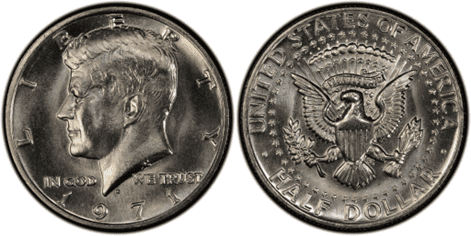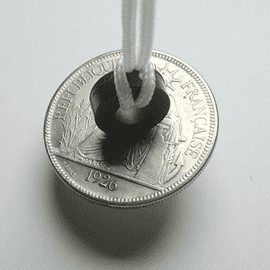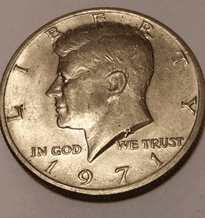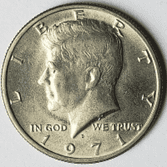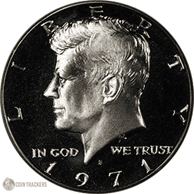What Is A 1971 Kennedy Half Dollar Made Of?
John F. Kennedy was assassinated in 1963. As a way to honor his death, a new half-dollar coin was introduced in 1964 which featured the president.
Prior to this, the half dollar was graced by Benjamin Franklin, one of the Founding Fathers of the United States. The Franklin half dollar has been circulated since 1948 and it was designed by John R. Sinnock, the former Chief Engraver of the United States Mint.

photo source: PCGS
The half-dollar was used to be made of 90% silver and 10% copper. However, this was changed in 1965 when it was transformed into what they call “silver-clad,” which means, 40% silver and 60% copper.
There were two designers of the Kennedy half-dollar. On the obverse side, Gilroy Robert designed the bust of Kennedy. On the reverse side, Frank Gasparro designed the heraldic eagle.
The Kennedy half-dollar once again went through some changes after the Coinage Act of 1969 was ratified. Because of this, silver was completely removed from the half dollar and a one-dollar coin was made to honor Dwight D. Eisenhower, the World War II general.
The change was signed and approved by President Richard M. Nixon.
In 1971, the Kennedy half-dollar was made of 75% copper and 25% nickel, which was later called “copper-nickel clad.” This was the first time the metallic combination was used for the half dollar. The same metallic composition was also used for the dime in 1965.
Throughout its production, the Kennedy half-dollar didn’t see any change in its design and size. However, the weight decreased a little bit — from 11.5 to 11.3 grams.
How Can You Tell If Your 1971 Kennedy Half Dollar Has Silver?
There are different ways you can determine whether your Kennedy half dollar has silver or not.
Remember that the first Kennedy half-dollar coins were the ones made of 90% silver. This means that if your coin shows the year, “1964,” then your coin is made of silver. Coins made in 1965, 1966, and 1967 still have silver in them but not as much as those minted in 1964.
If you have the 1971 Kennedy half dollar, it is most likely to be made of copper and not silver.

photo source: Silver Coins
You can test whether your coin is made of silver or not using a magnet. If the magnet attracts your coin and the coin sticks to the magnet, then it is not made of silver.
If it is okay with you, you can grab a sharp object and scratch it against the coin. If the mark made by the sharp object leaves a silver color, then it is most likely to be made of silver.
Another way to determine whether your Kennedy half dollar is made of silver or not is to check its edge. A silver coin would have a silver stripe. If the edge comes with a reddish-brown stripe, then it can be made of copper.
1971 Half Dollar Varieties
The 1971 half dollar comes with varieties. These include the 1971 half dollar with no mint mark, the 1971 D half dollar, 1971 S half dollar, and other varieties with errors. The face value of this coin is $0.50.
To give you an example, here are some quick details about the standard 1971 half dollar varieties according to their mint marks:
1971 No Mark Half Dollar
Mint Mark: None
Type: Kennedy
Edge: Reeded
Face Value: 0.50 USD
Market price: $0.60 to $45.00 (or more)
Coins produced: 155,164,000

photo source: NGC
1971 D Half Dollar
Mint Mark: P
Type: Kennedy
Edge: Reeded
Face Value: 0.50 USD
Market price: $0.60 to $3.00 (or more)
Coins produced: 302,097,000

photo source: eBay
1971 S Half Dollar
Mint Mark: S
Type: Kennedy
Edge: Reeded
Face Value: 0.50 USD
Market price: $1 to $40.00 (or more)
Coins produced: 3,220,000

photo source: Coin Trackers
Generally speaking, the 1971 half dollar was not entirely made of silver as mandated by the Coinage Act of 1969. So, whatever variety you might have, they are no longer made of silver but 75% copper and 25% nickel.
The mint mark tells you where a dollar is struck and minted. The 1971 half dollar with no mint mark is more likely to have been minted in Philadelphia. The 1971 D half dollar was made in Denver while the 1971 S half dollar was made in San Francisco.
Perhaps, the biggest and most sought-after error for the 1971 half dollar would be the one made with a 40% silver composition.

photo source: CoinArt
In 1971, it was mandated that no half dollar should be made with silver. However, some planchets that were made with silver made it through the minting process. Thus, there are rare half-dollar Kennedy coins that were made with silver but bear the year 1971.
According to some historians, the error happened when some silver-made planchets were left in the bins. When these bins were emptied and removed, the silver planchets instead went into the hopper. They were then later struck and so, we have the silver 1971 Kennedy half-dollar.
What Makes A 1971 Kennedy Half Dollar Rare?
The 1971 Kennedy half dollar isn’t actually rare. There were millions of half-dollar Kennedy coins minted throughout the years. However, what makes the 1971 Kennedy half dollar is the one that was accidentally made with silver.
As mentioned above, all 1971 half-dollar Kennedy coins should already be made of copper and nickel. No coins should be silver. However, there were old silver planchets left in the minting factories. These planchets were accidentally included in the process and struck.
Thus, the rarest 1971 Kennedy half-dollar is made of about 40% of silver.
What makes a 1971 Kennedy half dollar valuable?
For many, the 1971 Kennedy half-dollar isn’t much. Because the standard half-dollar coin isn’t that rare and due to its modern mintage date, you won’t be able to sell it at a higher price. Just to give you an idea, a half-dollar Kennedy with MS-60 condition is $1 while MS-63 is $2. Even in such good condition and high grade, they are still priced at a low price.
However, there are still half-dollar coins that are valued more. For example, MS-65 half-dollar coins are priced at $40. MS-66 graded coins are priced at $225. It’s worth noting that there are only less than 200 Kennedy half-dollar coins that are graded MS-66.
We have mentioned the rare 1971 silver half-dollar Kennedy coin. Since this is a rare coin, its value increases significantly. In one auction, the rare silver coin was bought at $6,000.
Please note that prices would also tend to go up with the passing years. So, the older your coin gets, the more expensive it will be.
What are the rarest kinds of 1971 Kennedy half dollar?
The rarest 1971 Kennedy half-dollar coin is the 1971-D Planchet Error. It also tends to be the most expensive. The 1971 half-dollar silver coin was accidentally struck, making it rare and only a few of them survive today.
How Much Is A 1971 Kennedy Half Dollar Worth Today?
The standard 1971 Kennedy half-dollar is worth around $1-2. However, a half-dollar with a higher grade can cost a few hundred dollars. The rare silver 1971 half-dollar Kennedy dollar is worth thousands of dollars. The usual melt value of the half-dollar Kennedy coin would be about $4.
How Does The Grading System Work?
The Sheldon Scale is used by numismatists to provide a numerical value to coins. The Sheldon Scale goes from poor (P-1) to perfect mint state (P-1) (MS-70). Coins were originally evaluated using words to reflect their condition (Good, Fair, Excellent, Etc.). Unfortunately, coin collectors and dealers had different ideas about what each of these terms represent.
Professional numismatists joined together in the 1970s and established CoinGrading standards. These numismatists now assign grades at key places on the seventy-point scale, using the most regularly utilized numeric points in conjunction with the original adjective grade. The following are the most common coin grades:
-
-
- (P-1) Poor – Indistinguishable and probably damaged; if used, must have a date and mintmark; otherwise, rather battered.
- (FR-2) Fair – Nearly smooth, but without the damage that a coin graded Poor often possesses. The coin must have enough detail to be identified.
- (G-4) Fair – Inscriptions have merged into the rims in some areas, and important elements have been mostly erased.
- (VG-8) Very Good- A little weathered, but all of the primary design elements are visible, albeit faintly. There is little if any, central detail left.
- (F-12) Good – The item is very worn, yet the wear is even, and the overall design details stand out clearly. Rims are almost completely isolated from the field.
- (VF-20) Very Fine – Moderately weathered, with some finer features still visible. The motto or all letters of LIBERTY are readable. Both sides of the coin have entire rims that are separated from the field.
- (EF-40) Extremely Fine – Gently used; all gadgets are visible, and the most important ones are bold. The finer details are bold and clear, however, light wear may be seen.
- (AU-50) Uncirculated – Slight evidence of wear on the coin’s design’s high points; may have contact marks; eye appeal should be adequate.
- (AU-58) Uncirculated Choice – Slight traces of wear, no severe contact marks, almost full mint shine, and great eye appeal.
- (MS-60) Mint State Basal – Strictly uncirculated; no indication of wear on the coin’s highest points, but an unsightly coin with reduced luster, visible contact marks, hairlines, and other flaws.
- (MS-63) Mint State Acceptable – Uncirculated, but with contact scratches and nicks, little reduced shine, but otherwise appealing appearance. The strike is weak to average.
- (MS-65) Mint State Choice – Uncirculated with great mint shine, very little contact blemishes, and exceptional eye appeal. The strike is unusually severe.
- (MS-68) Mint State Premium Quality – Uncirculated with superb luster, no obvious contact marks to the naked eye, and exceptional eye appeal. The strike is quick and appealing.
- (MS-69) Almost Perfect Mint State – Uncirculated with perfect brilliance, a sharp and appealing strike, and extremely good eye appeal. A near-perfect coin with minor imperfections in the planchet, strike, and contact markings (seen only under 8x magnification).
- (MS-70) Mint State Perfect – Under 8x magnification, there are no tiny imperfections discernible; the strike is crisp, and the coin is perfectly centered on a beautiful planchet. Rarely seen on a coin, this coin is bright and whole, with original luster and exceptional eye appeal.
-
Where To Buy Or Sell 1971 Half Dollars?
If you’re planning to buy or sell 1971 half-dollar coins, you would surely find them online. In this digital age, a quick Google search will give you numerous results. The Internet is also a good place for you to sell your coins.
Aside from the web, you can also visit antique stores, collectors’ hubs, and pawnshops. There are also stores that specialize in selling and buying coins. So, you can also give them a try.
FAQs
Where is the mint mark on a 1971 Kennedy half dollar?
The mint mark is found underneath the bust of Kennedy. The mint mark can be D, S, P, or W.
Is a 1971 Kennedy half dollar 40% silver?
No, the standard 1971 Kennedy half-dollar is made of nickel and copper. However, there are rare 1971 half dollar coins that were struck, which are made of 40% silver.
Which Kennedy half dollar is most valuable?
The most valuable Kennedy half dollar is the 1971 40% silver coin, which was created after old silver planchets were accidentally included in the minting process.
What should you look for in a 1971 Kennedy half dollar?
If you want to obtain the most expensive half-dollar coin, you need to check for its composition. Look for a 1971 half-dollar coin made of silver. That’s the rarest and most expensive variety.

